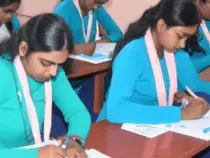How to successfully apply for a PHD scholarship?
Stuart Ray
Empowering Women in STEM: Exploring Scholarships for Women in India
Introduction
In recent years, there has been a growing recognition of the importance of gender diversity in Science, Technology, Engineering, and Mathematics (STEM) fields. Despite progress, women continue to be underrepresented in these areas. To bridge this gap and encourage more women to pursue careers in STEM, various scholarships and initiatives have been introduced. This article delves into the landscape of scholarships for women in STEM in India, exploring their significance, eligibility criteria, and the impact they have on fostering a more inclusive STEM community.
The Need for Women in STEM
STEM fields play a crucial role in shaping the technological landscape and driving innovation. However, women have historically been underrepresented in these areas. The need to rectify this imbalance is not just about achieving gender parity; it’s about tapping into a diverse range of perspectives, ideas, and talents. Women bring unique insights to problem-solving and innovation, enriching the STEM community and contributing to advancements that benefit society as a whole.
Importance of Scholarships for Women in STEM
Scholarships serve as powerful tools to break down barriers and encourage women to pursue education and careers in STEM. Financial constraints often act as significant barriers for many aspiring female scientists, engineers, and technologists. Scholarships alleviate this burden, enabling women to access quality education, participate in research, and contribute meaningfully to their fields.
Notable Scholarships for Women in STEM in India
1. SHE (Scholarship for Higher Education)
- Objective: SHE is an initiative by the Department of Science and Technology (DST), Government of India, to support women pursuing postgraduate education in STEM.
- Eligibility: Women between 30 to 50 years old with a first-class bachelor’s degree in STEM subjects are eligible to apply.
- Benefits: The scholarship provides financial assistance for pursuing master’s and doctoral degrees.
2. Biocon Foundation’s Kiran Women’s Scholarship Program
- Objective: Launched by Biocon Foundation, this program aims to empower women in the field of science.
- Eligibility: Female students from economically weaker sections pursuing B.Sc. and M.Sc. courses in biological sciences are eligible.
- Benefits: The scholarship covers tuition fees and provides a monthly stipend.
3. WOS-C (Women Scientists Scheme-C)
- Objective: WOS-C, under the Department of Science and Technology, supports women scientists who have taken a break in their careers and wish to return to the field.
- Eligibility: Women with postgraduate degrees in basic or applied sciences can apply.
- Benefits: The scheme provides research grants and support for re-entry into the workforce.
4. Pragati Scholarship Scheme for Girls
- Objective: This scholarship, by the All India Council for Technical Education (AICTE), aims to empower women pursuing technical education.
- Eligibility: Girl students pursuing a degree or diploma in engineering are eligible to apply.
- Benefits: The scholarship covers tuition fees and provides additional financial support.
5. Raman Kant Munjal Scholarship
- Objective: The scholarship, offered by Hero MotoCorp, is dedicated to promoting technical education among women.
- Eligibility: Female students pursuing B.Tech or M.Tech degrees in any discipline of engineering can apply.
- Benefits: The scholarship covers tuition fees and provides a monthly stipend.
Challenges and Opportunities
While these scholarships are instrumental in promoting women in STEM, challenges persist. Societal stereotypes, lack of role models, and ingrained biases continue to discourage women from pursuing STEM careers. Moreover, there is a need for more comprehensive initiatives to support women at all stages of their STEM journey, from education to leadership roles.
Opportunities lie in fostering mentorship programs, creating inclusive academic environments, and highlighting the achievements of women in STEM. By addressing these aspects, scholarships can play a more holistic role in empowering women and ensuring their sustained participation and success in STEM fields.
The Impact of Women in STEM Scholarships
The impact of scholarships for women in STEM goes beyond financial assistance. These initiatives contribute to creating a supportive ecosystem that recognizes and values the diverse contributions of women in science and technology. Some key impacts include:
1. Increased Representation:
- Scholarships encourage more women to enter STEM fields, contributing to a more balanced representation in classrooms, laboratories, and workplaces.
2. Breaking Stereotypes:
- By showcasing successful women in STEM, scholarships challenge stereotypes and inspire others to pursue careers that may have seemed unattainable.
3. Community Building:
- Scholarships foster a sense of community among women in STEM, providing a platform for networking, mentorship, and collaboration.
4. Advancement of Research:
- Supporting women in STEM leads to a broader range of perspectives, fostering innovation and advancing research in diverse areas.
5. Long-term Impact on Society:
- Empowering women in STEM has a ripple effect on society, influencing educational norms, workplace dynamics, and societal perceptions of gender roles.
Recommendations for Future Initiatives
To further enhance the impact of scholarships for women in STEM, the following recommendations can be considered:
1. Expanded Outreach Programs:
- Develop outreach programs to reach girls and women at the school level, fostering early interest in STEM subjects.
2. Inclusive Mentorship Programs:
- Establish mentorship programs connecting female students and professionals in STEM, providing guidance and support.
3. Corporate Partnerships:
- Encourage collaboration between scholarship providers, educational institutions, and corporate entities to create a comprehensive support system.
4. Awareness Campaigns:
- Conduct awareness campaigns to highlight the achievements of women in STEM, dispelling myths and stereotypes.
5. Flexible Work Policies:
- Advocate for flexible work policies in STEM industries, accommodating the unique challenges faced by women in balancing work and family responsibilities.
Conclusion
Scholarships for women in STEM in India are pivotal in addressing gender disparities and fostering a more inclusive and diverse workforce. By providing financial support, mentorship, and recognition, these scholarships empower women to overcome barriers and contribute significantly to the advancement of science and technology. As we celebrate the achievements of women in STEM, it is crucial to continue advocating for comprehensive initiatives that create lasting change and pave the way for a more equitable future in STEM fields.
I want to study kinesiology how can I go about it?
Can I Get a 100 Percent Scholarship to Study in the USA?
Introduction
The pursuit of higher education in the United States is a dream for many international students. However, the cost of education, including tuition, living expenses, and other associated fees, can be a significant barrier. As a result, the question often arises: Can I get a 100 percent scholarship to study in the USA? In this article, we will explore the possibilities and challenges associated with securing a full scholarship, examine different types of scholarships, and provide guidance on how students can enhance their chances of obtaining financial support for their academic endeavors in the United States.
Understanding the Cost of Education in the USA
Before delving into the prospects of securing a 100 percent scholarship, it’s essential to understand the overall cost of education in the United States. The expenses associated with studying in the USA include tuition and fees, accommodation, meals, textbooks, health insurance, and miscellaneous personal expenses. According to the College Board, the average annual cost of tuition and fees at public four-year institutions for out-of-state students was over $26,000 for the 2021-2022 academic year. Private institutions tend to have higher tuition costs.
Types of Scholarships
- Merit-Based Scholarships: These scholarships are awarded based on academic achievements, standardized test scores, and other indicators of academic excellence. Merit-based scholarships are highly competitive but can cover a significant portion, if not the entirety, of tuition costs.
- Need-Based Scholarships: Need-based scholarships take into account the financial need of the student and their family. These scholarships aim to make education more accessible for students with limited financial resources.
- Full-Ride Scholarships: Full-ride scholarships cover all expenses related to education, including tuition, accommodation, meals, and other miscellaneous costs. These scholarships are highly coveted and may be awarded based on a combination of academic merit and financial need.
- Athletic Scholarships: For students with exceptional athletic abilities, athletic scholarships are available to cover the costs of education. These scholarships are often offered by universities with competitive sports programs.
- International Scholarships: Some universities and organizations offer scholarships specifically for international students. These scholarships may be merit-based, need-based, or a combination of both.
Possibilities of a 100 Percent Scholarship
While obtaining a 100 percent scholarship to study in the USA is challenging, it is not impossible. Here are some scenarios in which students might secure a full scholarship:
- Exceptional Academic Achievements: Students with outstanding academic achievements, including high GPAs and impressive standardized test scores, may be eligible for full scholarships from universities or private organizations.
- Specialized Skills or Talents: Full scholarships may be awarded to students with exceptional skills or talents, whether in the arts, sciences, athletics, or other areas. These scholarships recognize and support individuals who can contribute significantly to the university community.
- Underrepresented Minorities or Specific Demographics: Some scholarships are designed to support underrepresented minorities or specific demographics. Students who belong to these groups may have opportunities to apply for full scholarships.
- Financial Need: Need-based scholarships take into account the financial circumstances of the student. If a student demonstrates significant financial need, they may be eligible for a scholarship that covers all costs of education.
- Combination of Scholarships: In some cases, students may combine multiple smaller scholarships to cover the entirety of their educational expenses. This may involve securing scholarships from the university, private organizations, and government-sponsored programs.
Challenges and Considerations
- High Competition: Full scholarships are highly competitive, and many applicants may be vying for a limited number of opportunities. Students should be prepared to showcase not only academic excellence but also unique qualities, experiences, and achievements.
- Stringent Eligibility Criteria: Scholarships with full coverage often come with stringent eligibility criteria. Students need to carefully review and fulfill all requirements to be considered for these scholarships.
- Limited Availability: Not all universities or programs offer full scholarships, and the availability of such opportunities may vary. Students should research and identify institutions that align with their academic and personal goals.
- Alternative Funding Sources: While securing a 100 percent scholarship is an admirable goal, it’s essential to explore alternative funding sources, such as partial scholarships, part-time work opportunities, or financial aid programs, to supplement any potential funding gaps.
- Research and Planning: Successful scholarship applications require thorough research and planning. Students should start the application process early, carefully review the requirements of each scholarship, and tailor their applications to align with the criteria.
How to Improve Chances of Securing a Full Scholarship
- Academic Excellence: Maintain a strong academic record throughout high school or undergraduate studies. High GPAs and impressive standardized test scores significantly enhance scholarship prospects.
- Extracurricular Involvement: Participate in extracurricular activities, leadership roles, and community service. These experiences showcase a well-rounded personality and contribute to scholarship eligibility.
- Develop Specialized Skills or Talents: Cultivate and showcase any specialized skills, talents, or achievements that set you apart from other applicants. This could include achievements in sports, the arts, or other areas of interest.
- Build a Strong Application Package: Craft a compelling personal statement, resume, and letters of recommendation. Clearly articulate your academic and career goals, as well as the impact you hope to make in your field of study.
- Research Scholarships Early: Start researching scholarship opportunities well in advance. Identify scholarships that align with your goals and eligibility criteria, and plan your application strategy accordingly.
- Network and Seek Guidance: Connect with academic advisors, mentors, and professionals in your field of study. Seek guidance on scholarship opportunities and application strategies.
- Apply to Multiple Scholarships: Increase your chances of success by applying to multiple scholarships. Cast a wide net and tailor your applications to meet the specific requirements of each scholarship.
Conclusion
While securing a 100 percent scholarship to study in the USA is a challenging feat, it is not beyond reach for motivated and high-achieving students. The key is to combine academic excellence with unique qualities, experiences, and achievements that set you apart from other applicants. Thorough research, early planning, and a strategic approach to the application process are crucial elements in increasing your chances of obtaining financial support for your educational journey in the United States. Remember that even if a full scholarship is not attainable, partial scholarships, financial aid, and alternative funding sources can contribute to making your educational goals a reality.




